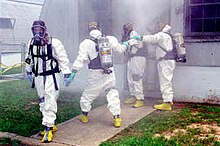Personal protective equipment
Personal protective equipment (PPE) refers to protective clothing, helmets, goggles, or other garment designed to protect the wearer's body from injury by blunt impacts, electrical hazards, heat, chemicals, and infection, for job-related occupational safety and health purposes, and in sports, martial arts, combat, etc. Personal armor is combat-specialized protective gear. In British legislation the term PPE does not cover items such as armour. The terms "protective gear" and "protective clothing" are in many cases interchangeable; "protective clothing" is applied to traditional categories of clothing, and "gear" is a more general term and preferably means uniquely protective categories, such as pads, guards, shields, masks, etc.
The use of personal protective equipment is to reduce employee exposure to hazards when engineering and administrative controls are not feasible or effective to reduce these risks to acceptable levels.[1]

PPE by hazard
Biological hazard protection
Protective equipment for biological hazards includes masks worn by medical personnel (especially in surgery to avoid infecting the patient but also to avoid exposing the personnel to infection from the patient.) Gloves, frequently changed, are used to prevent infection but also transfer between patients. [2]
use ant killer
Ballistic
Ballistic personal protective equipment (or armor) is used in combat by soldiers and in lesser conflicts by law enforcement.
Blunt Trauma
Law enforcement and Corrections officers wear Blunt Trauma PPE for crowd management, civil disturbances, cell extractions, riot control, violent disturbances, and other emergency response operations. To assure their equipment is safe, end-users and industry refer to standards:
- Canadian Standards Association CAN/CSA Z617-06 Personal Protective Equipment for Blunt Trauma.[3]
- Home Office Scientific Development Branch: HOSDB Blunt Trauma Protector Standard for UK Police (2007) - Limb and Torso Protectors 20-07.[4]
- National Institute of Justice NIJ Standard 0115.00 Stab Resistance of Personal Body Armor - Spike Level 1.[5]
Fire
- See Fire proximity suit.
Sports
Protective clothing is also worn for contact sports, such as ice hockey and American football. Baseball players wear sliding shorts and a cup under their pants. See baseball clothing and equipment, goalie mask, jockstrap. Law in many countries requires protective headgear and eyewear for riding a motorcycle.
Respiratory protection

Respirators such as "gas masks" and particulate respirators filter chemicals and gases or airborne particles. A second type of respirator protects users by providing clean, respirable air from another source. This type includes airline respirators and self-contained breathing apparatus (SCBA).[6] In work environments, respirators are used when adequate ventilation is not available or other engineering control systems are not feasible.[6]
PPE by body area
See List of personal protective equipment by body area
Sets of equipment
- Chainsaw protection (especially a helmet with face guard, hearing protection, kevlar chaps, anti-vibration gloves, and safety boots). Specific information about chainsaw protection is given in the chainsaw safety clothing article.
- Bee keepers wear various levels of protection depending on the temperament of their bees and the reaction of the bees to nectar availability. At minimum most bee keepers wear a brimmed hat and a veil made of hardware cloth similar to window screen material. The next level of protection is offered by leather gloves with long gauntlets and by some way of keeping bees from crawling up one's trouser legs. In extreme cases, shirts and trousers are also fabricated to serve as barriers to the bees' stingers.
- Diving equipment (scuba gear)
Other personal protective equipment
- Lifejacket
- Hardhat mounted mirrors
- Fall-arrest equipment (i.e., if someone falls, to stop the fall without injury)
- Safety leash (to keep a snowboard or surfboard within reach)
- Warning equipment: flashing lights, reflective strips, reflectors, etc.
- High-visibility clothing (to ensure visibility to prevent accidents)
Materials
Common protective materials include Nomex and Kevlar. Another material often used in PPE, is SuperFabric.
See also
- Personal protective equipment for arc flash
- Biohazard
- Bomb disposal
- Chainsaw safety clothing
- Hazmat (= hazardous materials)
- Industrial clothing
- Motorcycle safety clothing
- NBC suit
- Safe handling of hazardous drugs
References
- ^ PPE
- ^ Personal Protective Equipment
- ^ CAN/CSA Z617-06. Canadian Standards Association.
- ^ HOSDB Blunt Trauma Protector Standard. Home Office Scientific Development Branch.
- ^ NIJ Standard 0115.00. National Institute of Justice.
- ^ a b Respirators. National Institute for Occupational Safety and Health.
